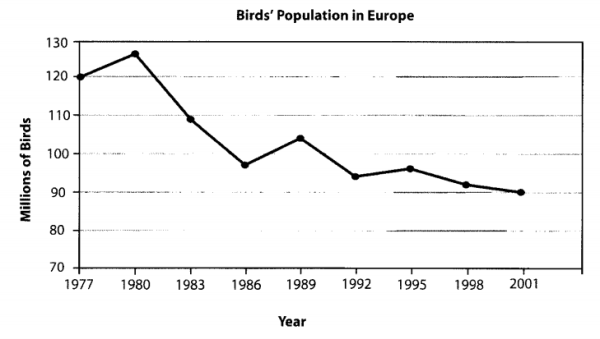Sách này cổ rồi nên chắc nhiều bạn không biết. Mình đang đọc nhanh để soạn đề cương dạy trong kỳ này và thấy có một đoạn miêu tả số liệu như dưới đây rất hợp lý. Mình trích lại bản gốc để các bạn tham khảo rồi áp dụng cho bài Share Price.
Bản gốc như sau:
Over the last year we have seen different developments in both interest rates on our loans and our monthly sales figures. Interest rates began in January at 2.5%. They then went up slowly and levelled off in March at 2.65%. There was a modest drop back to 2.5% in April but in May we saw a noticeable increase until they peaked in June at 3.45%. In August they fell suddenly again and bottomed out at 2.3% in September. Then we saw a slight rise to 2.4% in October. Since then they have been climbing steadily and have now finished the year at 3.75%. Our sales figures have also fluctuated in the past year. We started off in January with figures of €80,000 and this figure grew considerably over the next two months. They reached a peak in March at €120,000 fell slightly and then remained stable through April. Then in May we saw a modest slump to €100,000 but in June they plunged and continued to decrease rapidly until they hit a low at €45,000 in July and stagnated till the end of August. Luckily, they began to recover in September and improved consistently reaching €75,000 in October. They then soared in November and we ended the year at €115,000-a substantial improvement.
Chỗ nào thấy hợp lý mình sẽ phân tích và thử áp dụng. Tuy nhiên, do mình chỉ định áp dụng cho một đề thôi nên sẽ có những ghi chú mình không có câu nào để minh họa cả.
They then went up slowly and levelled off in March at 2.65%… thì mình đổi vài chữ, ví dụ they đổi thành this figure đi với then quá hợp lý. Ngoài ra, mình ít khi dùng level off nên muốn ghi chú lại ở đây là cần đưa thêm số liệu, ví dụ at 2.65%, chứ đừng như fluctuate toàn đi một mình.
There was a modest drop back to 2.5% in April… thì mình chưa tự tin áp dụng cho đề Share Price vì back to có lẽ nên đi với this figure theo công thức with S V-ing của Simon. Mình ví dụ nhé:
There was a modest drop in interest rates in April, with these figures falling back to 2.5%.
Cụm in interest rates là mình tự thêm vào. Mình nghĩ là sẽ bị trừ điểm nếu các bạn bỏ cụm này. Áp dụng ta có:
Over the following two years, there was a gradual decrease in the price of a share of these companies, with this figure falling back to its starting point in Dec. 2010.
Điểm dở là decrease và falling như kiểu bị lặp vậy. Nếu là xu thế ngược lại thì mình sẽ dùng reaching thì rất đáng tiếc lại không thể nhét back to vào. Chỗ này mà fluctuate thì nghe ra còn được.
Over the following two years, there were fluctuations in the price of a share of these companies, with this figure falling back to its starting point in Dec. 2010.
… in May we saw a noticeable increase until they peaked in June at 3.45% có một cách miêu tả giống câu dưới đây, nhưng hay hơn nhiều.
Two months later, interest rates increased noticeably, reaching a peak at 3.45% in June.
Câu này của mình không chắc là tương đương với câu gốc vì cả increased và reaching a peak đều phải thuộc cùng một giai đoạn, là khoảng tăng tính từ tháng tư đến đỉnh là tháng sáu. Cách miêu tả của bản gốc đơn giản mà hiệu quả hơn. Áp dụng luôn:
In 2006, Outokumpu companies saw a noticeable growth in their share price until it peaked at 31.5EUR in Jan. 2007.
… bottomed out at 2.3% in September phải thử luôn vì mình ít khi để ý đến đáy. Áp dụng ngay:
8 months later, the share price bottomed out at 7.5EUR in Dec. 2008.
Chợt nhận ra là miêu tả thế này thì không có khoảng. Ví dụ như dưới đây nghe còn được.
8 months later, the share price fell substantially, hitting its lowest point at 7.5EUR in Dec. 2008.
Then we saw a slight rise to 2.4% in October… có lẽ chỉ hợp với trường hợp we bị thay thế bằng Outokumpu companies. Thử nào:
Over the following 4 months, Outokumpu companies saw a slight rise in their share price to 30.5EUR in Apr. 2008.
… and have now finished the year at 3.75% là ghi chú mình đánh dấu cho vui chứ không dám áp dụng vào đề Share Price.
Với Our sales figures have also fluctuated in the past year thì mình chỉ định lưu ý chỗ sales figures.
We started off in January with figures of €80,000… là một cách miêu tả không ổn nếu đi thi, nhưng nghe cũng được nếu là bài thuyết trình trước công ty nên mình ghi lại.
… and this figure grew considerably over the next two months là cách miêu tả quen thuộc trong các bài cơ bản mình dạy trên trường, thêm by… thì quá đẹp.
They reached a peak in March at €120,000 fell slightly and then remained stable through April là một chuỗi ba điểm nhấn áp dụng được cho bài Bird Population là dạng đề một dây chứ áp dụng vào bài nhiều dây là thua. Các bạn nhớ là phải luôn luôn so sánh.
they hit a low at €45,000 in July vừa nhìn thấy phía trên xong. Mình sửa luôn:
Over the next 8 months, the price of a share of Outokumpu companies fell substantially, hitting a low at 7.5EUR in Dec. 2008.




